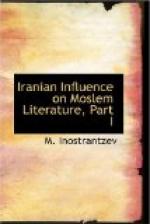IBN HAUKAL.
Ibn Haukal has been edited in the Bibliotheca Geogra phorum Arabicorum by De Goege, but as the text is not available the following excerpts from a translation of it made over a century ago by Sir William Ouseley will indicate its importance. He flourished in the middle of the 11th century.
[Sidenote: Fire Temples.]
“There is not any district nor any town of Fars without a fire temple. These are held in high veneration. We shall hereafter minutely describe them. Also throughout Fars there are castles one stronger than another.
[Sidenote: Nirang.]
“There is not any district of this province nor any without a fire temple. One near Shapur they call Kunbud Kaush.... And in the religion of the Guebres it is ordained that ’Omnis Foemina quae tempore gravid it at is aut tempore menstruorum, fornicationem seu adultarium fecerit, pura non erit, donec ad Pyraeum (seu templum Ignicolarum) accesserit (et) coram Heirbed (sacerdote) nuda ferit et urina vaccae se laverit.’
“In the province of Fars, they have three languages—the PARSI, which they use in speaking one to another, though there may be some variations of dialects in different districts yet it is in fact all the same and they all understand the languages of each other and none of their expressions or words are unintelligible; the Pahlavi language which was formerly used in writings; this language now requires a commentary or explanatory treatise; and the Arabic language which at present is used in the Divans or royal courts of justice and revenue, etc.




